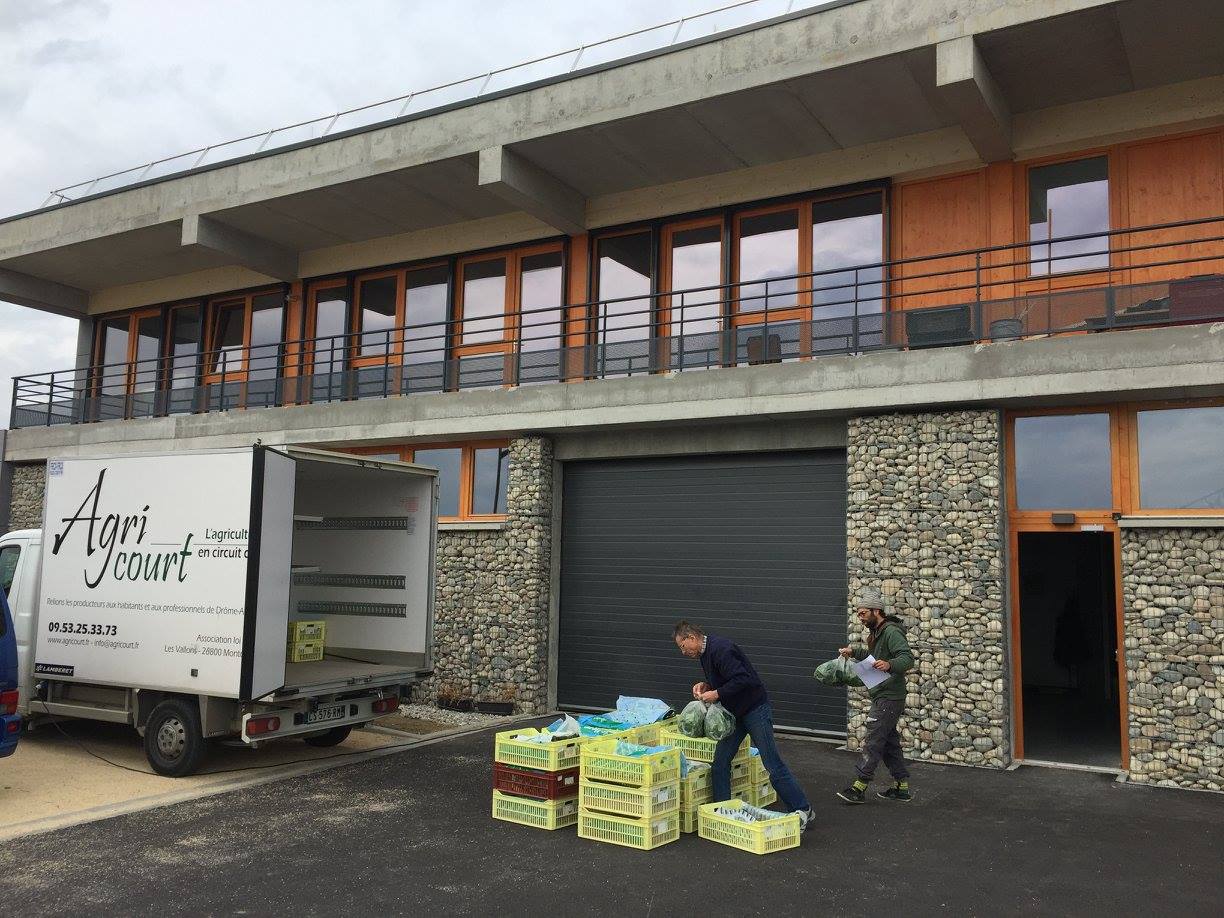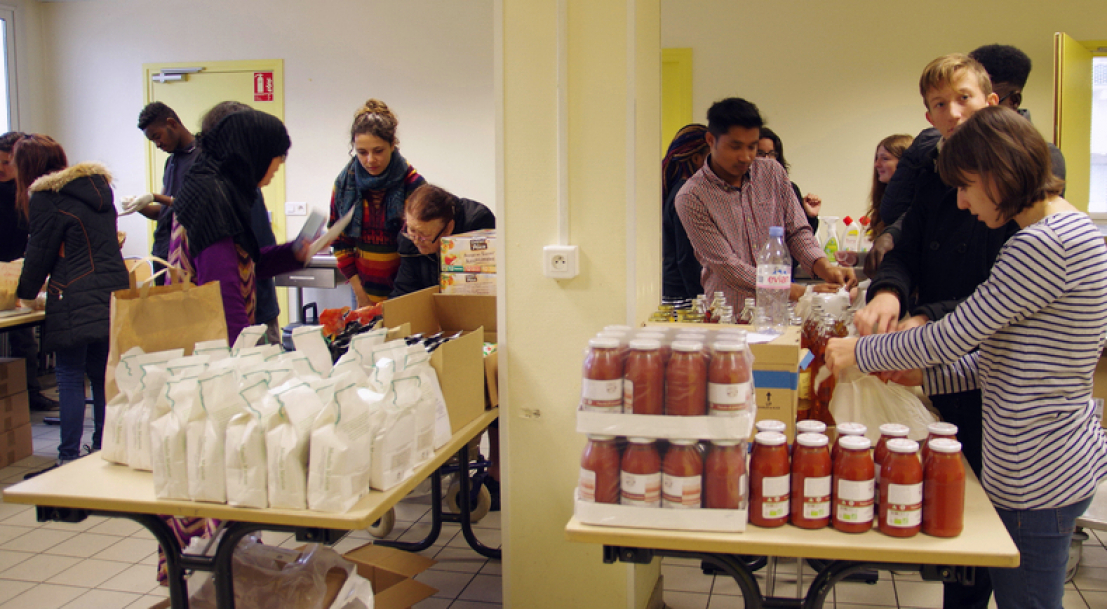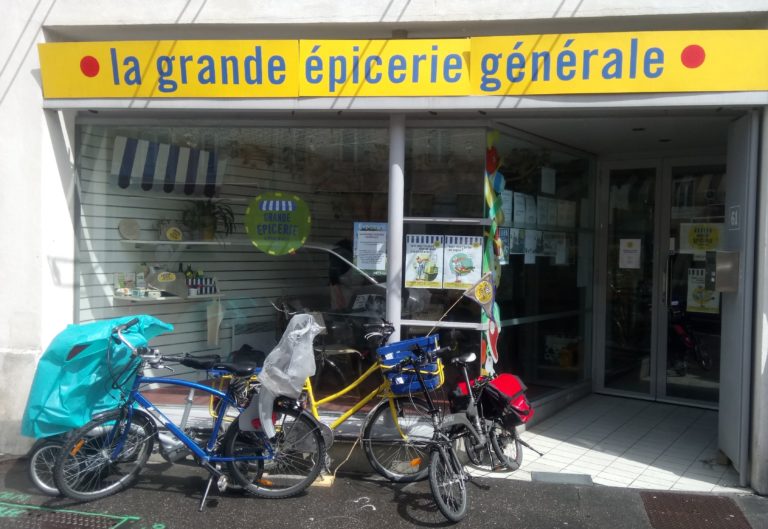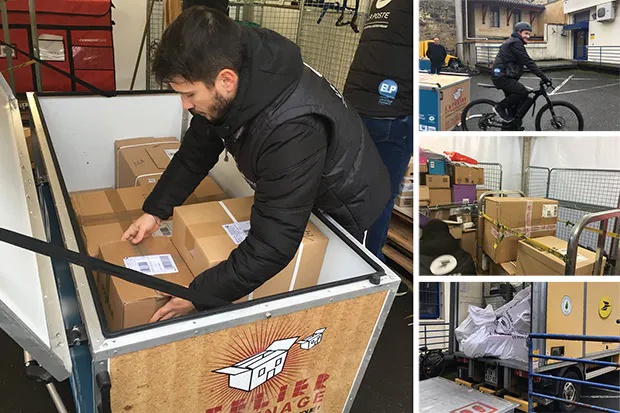Pathway to resilience n ° 9: Simplify and shorten logistics and food purchasing
- 2020-02-01 09:34:30.0
- 14614
- local channels, logistics
In the space of a few decades, the rise of the agri-food industries and mass distribution have revolutionized food logistics. Food is now mostly transported by cargo ships and trucks over thousands of kilometers, and routed in just-in-time flow to points of sale that are often inaccessible without a car. Anticipating the decline in oil production requires greatly reducing the distances traveled by food and consumers by deploying local distribution networks.
State of Affairs
Oil fills our plates
The logistical organization necessary for our food generates two main types of flows:
- transport of goods upstream of marketing, from production sites to processing plants, logistics platforms and finally final points of sale;
- the movement of consumers s for the purchase of food, that is to say the journeys of households to and from points of sale: retail stores and out-of-home catering .
Transport of goods Food supply has historically been at the heart of urban planning and organization. In European history, the means of transport enabling food to be transported from the countryside to the cities have always been an issue of public health and safety.

The Arpajonnais was a secondary railway on the road linking Paris to Arpajon (Essonne), put into service in 1893 and abolished in 1937. It provided service to the Halles de Paris by using the tracks of the urban tramways, then left with the waste from the Halles, which was then used as fertilizer in the fields. Crédits : domaine public, Wikimedia Commons.
Since 1950, the transport of goods has grown considerably, branched out and become more complex with the combined growth of international trade, the agri-food industry and mass distribution (Figure 28). All this was made possible by the abundance of petroleum fuels.

Figure 28 : French agro-food trade, in value, since 1995. The liberalization and development of international trade have led to a doubling of the value of exports and imports in about twenty years. Source : Agreste (2019).
Maritime transport, by bulk cargo and container ship, accounts for around 60% of the flow of food goods (Figure 29). This large share of tonne-kilometers can be explained more by the long distances traveled - nearly 10,000 km for a Santos (Brazil) - Lorient journey - than by the quantities transported. The products concerned are mainly concentrated feed intended for our farm animals (in particular soybean meal), as well as edible oils and exotic fruits.

Bulk cargo ship being loaded at the Dunkirk grain terminal. Soybean meal, exclusively dedicated to animal feed, generates a quarter of the total traffic of food goods to France, 86% of which by sea. Crédits : © JL Burnod – Happyday.

Figure 29 : Transport of food products by mode, for all French consumption, and corresponding CO2 emissions. The total flow is 200 Gt.km. Initial journey: for imported goods, transport between the place of production and the port of departure. Source : Barbier et al. (2019).
Road transport by truck accounts for 35% of the flow of food goods (Figure 29). In terms of the quantities transported, this is by far the majority mode. It largely predominates for all stages of land transport: moving agricultural production to processing plants, processed products between logistics platforms, then from platforms to final points of sale. This system works just in time . Inventories, which generate costs, are minimized as much as possible at each stage of the supply chain. Supermarkets thus receive several daily deliveries. Each day, the equivalent of 30,000 semi-trailers cross France to collect food, supply wholesale markets or food factories, consolidate the flow of goods, and deliver sales areas.

The Chesnes International Park, in Saint-Quentin-Fallavier (Isère), is the leading logistics zone in France and undoubtedly in southern Europe, with 300 companies over 1,000 hectares. Several hundred semi-trailers deliver to these consolidation centers every day, from which retailers are supplied. Today, more than 75% of food goods pass through national or regional warehouses, correspondingly increasing the distances traveled. Credits: © CAPI - ULM38. Rail, waterway and air transport are largely in the minority , since they together represent only 5% of total freight transport.
Food shopping trip
Quite downstream in the logistics chain is the movement of consumers to end points of sale: retail (supermarkets and hypermarkets in particular) or restaurants.
In the space of a few decades, most industrialized countries have gone from a network of retail businesses located in towns and city centers and within walking distance, to distribution overwhelmingly dominated by large and medium-sized stores located at the periphery (Figure 30) . This development has gone hand in hand with the decline of specialized shops, the number of which has been divided by 4 since 1950. Today in France, seven out of ten municipalities, corresponding to around ten million inhabitants, do not have access to 'no general food trade ,. In addition, other activities are migrating to the urban periphery in the wake of food businesses, emptying city centers.

Figure 30 : Food retail market in France in 2018 (as a% of the value including tax). Source : Les Greniers d’Abondance, from INSEE (2018).
As a result, 90% of food purchases are made by car, averaging 60 kilometers per week for a three-person household .
Although short in relation to the entire logistics chain, these journeys are very inefficient: they consist more or less of moving a ton of steel over several kilometers to transport a few kilograms of food! They thus represent 28% of the energy consumption of food transport. We can thus understand that the disappearance of local shops greatly increases the energy dependence of households : in supermarkets, the consumer's journey represents on average half of the energy consumption linked to transport. Finally, France is the country in Europe where large-scale distribution drives are the most developed (7.1% of market share). It is even ahead of the United States (5.6%).
Economic concentration of food distribution
The recent metamorphosis of distribution channels has been accompanied by an economic hyper-concentration of the sector . Successive mergers and acquisitions have helped build an oligopoly of international groups benefiting from significant economies of scale and strong negotiating power.
The purchasing centers owned by six brands (Auchan, Système U, Carrefour, Casino, Leclerc and Intermarché) represent 92% of the retail market (Figure 31).

Figure 31 : Concentration of food processing and distribution activities in France. Source : Les Greniers d’Abondance, d’après les données Agreste (2019) et Kantar World Panel (2016).
87% of sales of food products for home consumption are now made in large distribution and hard discount brands.
Links to resilience ?
Associated threats : climate change, depletion of energy and mineral resources, economic and political instability
As Françoise Laborde, Senator for Haute Garonne, sums it up: “Today, production and consumption are no longer territorialized, and even rural areas are“ food ”vulnerable, infused by the ballet of mass distribution trucks. ".
The food system is deeply dependent on petroleum for the movement of products and consumers . This situation is very worrying given the announced decline of this energy resource. The existence of critical logistics "nodes" such as consolidation platforms or large agrifood processing units constitutes an additional vulnerability in a context of economic and political instability and the strengthening of extreme weather events. Localized disturbances, even slight ones, can have disproportionate consequences on the functioning of the system.
On the other hand, just-in-time operation marks a fundamental break with the history of sedentary societies, where the building up of stocks and the existence of reserves were a vital necessity, especially in cities. These reserves were managed both within households and by the government and were an essential element of resilience.
A study by the American Trucking Association assesses the chain consequences of stopping road transport in the United States:
Within the first 24 hours, deliveries of medical supplies and mail would cease, and gas stations would run out of fuel.
- After the first day, food shortages would appear, the price of gasoline would rise and assembly lines would begin to close for lack of supply.
- On the second day, stocks of basic necessities would run out and garbage would accumulate in the streets.
- Within a week, car travel would cease due to the depletion of fuel reserves, and hospitals would face shortages.
Downstream in the chain, it is the middle and lower classes, the most represented in peri-urban and rural areas, who generate the most trips for the purchase of food. They are all the more vulnerable to the risk of rising oil prices or geopolitical crises reducing the country's oil supply.
Objectives
Reducing transport needs is an essential objective to improve the resilience of the food system . It is necessary to reduce both the transport of raw or processed food products, and the distances traveled by consumers for their food purchases.
In parallel with the development of nourishing agriculture that can meet the basic needs of the population of a given territory (see resilience path n ° 6), and local transformation tools (see resilience path n ° 8), appropriate distribution and marketing channels must be put in place to ensure the fluidity of the flow of goods between the various actors in the food system. This implies the structuring of territorialized sectors .
Consumer travel and car dependency can be considerably reduced by developing a local food offer, accessible on foot, by bike or by public transport . This must be part of the structuring elements of regional planning and economic development policies.
Actionnnable Levers
LEVER 1 : Taking food into account in urban planning
Local governments must promote economic activity in the city center or town center, in particular by redeploying public services there.
It is necessary to put an end to the development of large peripheral commercial areas, areas of predominantly commercial economic activity, and recent models such as drives , which directly compete with the economic activity of the center. city and can only be reached by car. Finally, development policies must stop urban sprawl , which increases the distances traveled by households to purchase food in addition to contributing to the artificialization of agricultural land (see resilience path no. ° 2).
LEVER 2 : Build shared distribution platforms for producers in the region
Managing orders and delivering products is a time-consuming activity, both for farmers and for restaurateurs, canteen managers and food traders. It can greatly gain in efficiency by setting up a distribution platform pooling management, storage and transport tools.
This is perhaps the most important "leverage" that a community can implement . The structuring of the sectors makes it possible both to relocate part of the consumption, to encourage the development of agroecological practices, to promote processing activities, to reduce transport distances, to ensure fair remuneration for producers and products. quality to consumers. The launch of this type of project requires a transversal study of the local food system. Public orders for collective catering can support the construction of these sectors .

In Isère, producers and processors certified "Organic Agriculture" have come together in a distribution platform "Eat Bio Isère", benefiting from a space at the National Interest Market of Grenoble-Alpes Métropole. This SCIC allows the pooling of deliveries for producers and supplies both collective catering places and food stores in the department. Crédits : © Mangez Bio Isère.

Agri Court is a distribution platform for organic and local products in Drôme and Ardèche. Its clients include both communities and restaurateurs as well as consumer groups. Crédits : © Agri Court.
LEVER 3 : Develop local distribution channels Communities can support the development of local distribution channels to diversify distribution methods in the bioregion and strengthen local supply . Many possibilities exist: traditional markets, producers' stores, local shops, AMAP, relay points ...

The association Towards a Joint Purchasing Network (VRAC) promotes the development of purchasing groups in disadvantaged neighborhoods of large cities (Lyon, Strasbourg, Paris, Bordeaux, Toulouse). It aims to provide as many people as possible access to quality products from peasant / organic / fair-trade agriculture at low prices, thanks to the reduction of intermediate costs (local channels) and superfluous (limitation of packaging). Crédits : © VRAC.

In Saint-Étienne, the association "From the farm to the neighborhood" offers a short-circuit solidarity food supply system, a local purchasing group, deliveries to relay points and a store for local produce. This platform benefits from the support of the Auvergne-Rhône-Alpes region and the city of Saint-Étienne, which provides premises for the store. Crédits : © De la ferme au quartier.
LEVER 4 : Promote the installation of local sales spaces Points of sale accessible without a car are to be developed by local authorities. They can take many forms, all of which allow the territory's productions to be marketed, with a variable number of intermediaries. Local authorities can provide support in different ways: setting up a project, providing premises, expert services, market research, networking, promoting the place, etc. These local business projects have every interest in being designed in conjunction with social action centers in order to make them effective means of combating food insecurity .
 The Boomerang grocery store in Mouans-Sartoux (Alpes-Maritimes) is a town center food store offering products from organic farming and from many farms in the department. The municipality supported the setting up of the project and access to a sales room. Crédits : © Épicerie Boomerang.
The Boomerang grocery store in Mouans-Sartoux (Alpes-Maritimes) is a town center food store offering products from organic farming and from many farms in the department. The municipality supported the setting up of the project and access to a sales room. Crédits : © Épicerie Boomerang.

In Nancy (Meurthe-et-Moselle), the Grande Épicerie Générale is an example of a cooperative food store, a model that is developing in France. The grocery store is managed by cooperative members who subscribe for shares. In exchange for a monthly working time (here three hours), the cooperative members can have access to the products offered for sale, Cooperative food shops are part of alternative consumption approaches which also promote the supply of local products and / or from organic farming See other examples of cooperative grocery stores and supermarkets. Crédits : © Grande Épicerie Générale.

The Marché Bus d'Alsace du Nord is a mobile food store that supplies several rural communities in Bas-Rhin. It provides a range of local products from organic farming to people who are often constrained in their mobility. Crédits : © Association des producteurs bio d'Alsace du Nord..
LEVER 5 : Develop "last mile" logistics solutions The pooling of last mile logistics makes it possible to optimize transport in urban areas.
In dense urban areas, build Proximity Logistics Areas (ELP) , platforms for consolidating goods, making it possible to pool rounds and deliver in low-carbon vehicles.
Offer the provision of shared public fleets (car sharing).

During works around the new Bordeaux Métropole tram line, a temporary Proximity Logistics Space was set up to deliver on foot or by bike to traders located near the road under construction, partially closed to local traffic. Crédits : © La Poste.
Side Benefits
The overall reduction in road transport (trucks and cars) reduces greenhouse gas emissions and atmospheric pollution in the territory, limits the degradation of the roadway by heavy goods vehicles and noise pollution, improves the flow of traffic.
The distribution channels built in partnership between producers and consumers guarantee fair remuneration for farmers and a quality food offer.
The development of local shops is an asset for the dynamism of city centers and the local quality of life. All of these developments create jobs and networks between the different actors in the food system.
Obstacles
Weak regulations
The rationalization of freight transport is hampered by the absence of incentive regulations at the national level (eco-tax or prohibitive carbon tax). Local authorities have no direct leverage to intervene in the upstream logistics chain. Alternative modes to the road are used very little today. Rail freight has halved since 1990. River freight is very underdeveloped, a situation which is all the more surprising given that France has the longest river network in Europe and uses it very little (3% of flows of transport) in comparison with its Dutch (43%), German (15%) and Belgian (12%) neighbors, and even to Europe in general (7%).
Divergent interests
Mass distribution has considerable economic power. The development of alternative distribution systems led by communities could locally go against their interests and generate tensions. Large-scale distribution - probably aware of the current limits and of the economic opportunities - is positioning itself more and more on local commerce, potentially competing with the initiatives carried by the public authorities.
Indicators
- Nombre de commerces alimentaires de proximité pour 100 habitants
- Distance moyenne des habitants à un commerce alimentaire
- Existence d’une plate-forme mutualisée de distribution des produits locaux
- Proportion de produits issus du département dans la restauration collective


